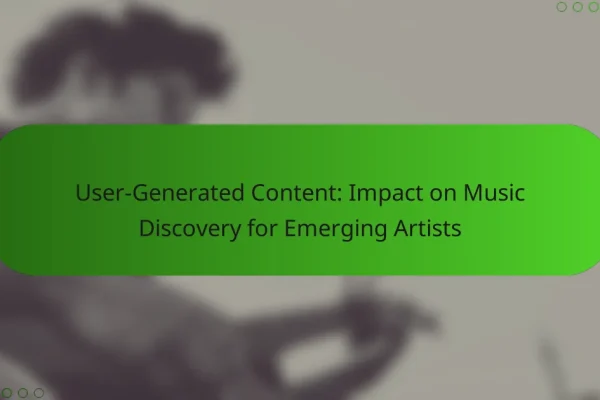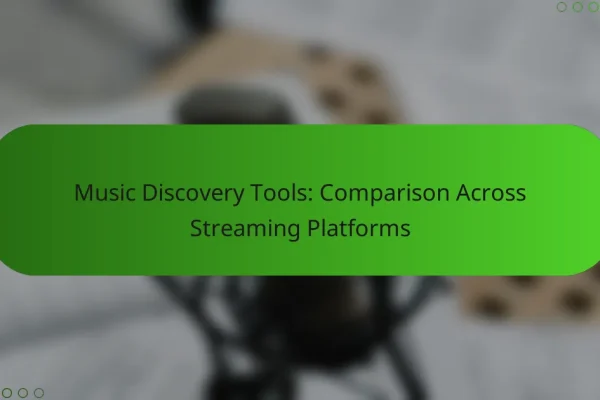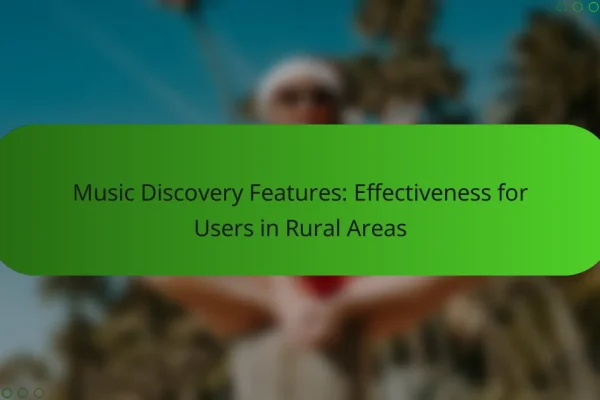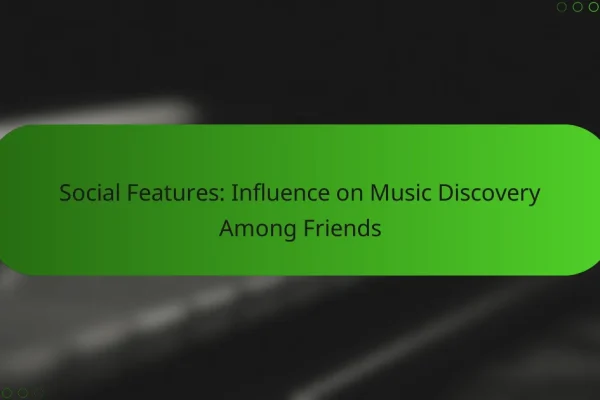How do music discovery features enhance streaming services?
Music discovery features significantly improve streaming services by helping users find new artists and tracks that align with their tastes. These features leverage data and algorithms to create a personalized listening experience, making it easier for users to explore diverse genres and discover hidden gems.
Personalized playlists
Personalized playlists are curated collections of songs tailored to individual users based on their listening habits. Streaming services analyze user data, such as previously played tracks and liked songs, to generate playlists like “Discover Weekly” or “Your Mix.” This approach not only introduces listeners to new music but also keeps their experience fresh and engaging.
To maximize the benefits of personalized playlists, users should regularly interact with the platform by liking or disliking songs. This feedback helps refine future recommendations, ensuring that playlists remain relevant and enjoyable.
Algorithmic recommendations
Algorithmic recommendations utilize complex algorithms to suggest music based on user preferences and behavior patterns. These systems often consider factors like song tempo, genre, and even the time of day to provide tailored suggestions. As a result, users can discover tracks that they might not have encountered otherwise.
To enhance the effectiveness of algorithmic recommendations, users can explore different genres or artists outside their usual preferences. This can lead to a richer music experience and broaden their musical horizons.
User-generated content
User-generated content, such as playlists created by other users, offers a unique way to discover music. Many streaming platforms allow users to share their playlists, which can introduce listeners to new tracks and artists curated by fellow music lovers. This community aspect fosters a sense of connection and shared discovery.
Engaging with user-generated content can be beneficial; users should explore playlists that align with their interests or those that are trending. This can lead to unexpected finds and a deeper appreciation for diverse music styles.
Social sharing capabilities
Social sharing capabilities enable users to share their favorite tracks and playlists with friends and followers. This feature not only enhances the discovery process but also encourages social interaction around music. Users can see what their friends are listening to, creating a communal experience that can lead to new musical discoveries.
To make the most of social sharing, users should actively participate by sharing their own playlists and engaging with others’ recommendations. This interaction can enrich their music library and foster a vibrant community of music enthusiasts.
What are the top music streaming platforms with discovery features?
The leading music streaming platforms with notable discovery features include Spotify, Apple Music, and YouTube Music. Each platform offers unique tools to help users discover new music tailored to their tastes, enhancing the listening experience.
Spotify’s Discover Weekly
Spotify’s Discover Weekly is a personalized playlist that updates every Monday, featuring songs based on your listening habits. The algorithm analyzes your music preferences and suggests tracks you haven’t yet explored, making it a great way to find new favorites.
To maximize the effectiveness of Discover Weekly, regularly listen to the playlist and engage with the recommended songs. Liking or saving tracks helps refine future recommendations, ensuring a more tailored experience over time.
Apple Music’s For You
Apple Music’s For You section curates playlists and album recommendations based on your listening history and preferences. This feature combines human curation with algorithmic suggestions, providing a blend of popular hits and hidden gems.
To get the most out of For You, consider rating songs and albums as you listen. This feedback helps Apple Music better understand your tastes, leading to more accurate recommendations that evolve with your musical journey.
YouTube Music’s Discover Mix
YouTube Music’s Discover Mix is a playlist that refreshes weekly, showcasing new tracks and artists aligned with your listening habits. It leverages YouTube’s vast library, offering a diverse range of genres and styles.
For optimal results, engage with the music by liking or disliking tracks in the Discover Mix. This interaction informs the algorithm, allowing it to provide more relevant suggestions and enhancing your overall music discovery experience.
How do algorithms improve music discovery?
Algorithms enhance music discovery by analyzing user behavior and preferences to recommend songs that align with individual tastes. This process involves leveraging vast amounts of data to identify patterns and suggest new music that listeners are likely to enjoy.
Data-driven insights
Data-driven insights are derived from user interactions, such as song plays, skips, and likes. Streaming platforms collect this information to create a comprehensive profile of listening habits. For example, if a user frequently listens to indie rock, the algorithm will prioritize similar genres in future recommendations.
These insights help platforms understand broader trends, allowing them to curate playlists that resonate with specific audiences. By analyzing aggregated data, streaming services can identify emerging artists and popular tracks, ensuring users discover fresh music that aligns with current tastes.
Collaborative filtering
Collaborative filtering is a technique that recommends music based on the preferences of similar users. By analyzing the listening habits of a group, algorithms can suggest songs that a user has not yet discovered but that others with similar tastes have enjoyed. This method relies heavily on user data and can be particularly effective in uncovering hidden gems.
For instance, if two users have a high overlap in their listening history, the system will recommend tracks that one user has enjoyed but the other has not yet explored. This approach fosters a sense of community and shared discovery among users.
Machine learning models
Machine learning models enhance music discovery by continuously learning from user interactions and improving recommendations over time. These models can analyze complex patterns in data, allowing them to adapt to changing preferences and trends. For example, a model might identify that a user has started enjoying a new genre and adjust its recommendations accordingly.
Streaming services often employ various machine learning techniques, such as neural networks, to refine their algorithms. This results in more personalized playlists and recommendations, making it easier for users to find music that resonates with them. Regular updates to these models ensure that the discovery process remains dynamic and relevant.
What role do user preferences play in music discovery?
User preferences are crucial in music discovery as they help tailor recommendations to individual tastes. Streaming platforms analyze user behavior and feedback to create personalized playlists and suggest new artists that align with listeners’ interests.
Listening history analysis
Listening history analysis involves examining the tracks and artists a user has previously engaged with. By tracking this data, platforms can identify patterns and suggest similar music that the user is likely to enjoy. For instance, if a user frequently listens to indie rock, the service may recommend emerging indie bands or related genres.
Many platforms employ algorithms that analyze listening habits over time, allowing for increasingly accurate recommendations. This method can enhance user satisfaction and keep listeners engaged with the service.
Explicit user feedback
Explicit user feedback refers to direct input from listeners about their music preferences, such as liking or disliking tracks. This feedback is instrumental in refining recommendations, as it provides clear signals about what users enjoy or want to avoid. For example, if a user consistently dislikes pop music, the platform can adjust its suggestions accordingly.
Some services also allow users to rate songs or provide comments, further enhancing the personalization of their music experience. Engaging with these features can lead to a more satisfying listening experience.
Demographic targeting
Demographic targeting uses information such as age, location, and gender to tailor music recommendations. By understanding the demographics of their user base, streaming platforms can promote genres and artists that resonate with specific groups. For example, younger audiences may receive more recommendations for trending hip-hop tracks, while older users might see classic rock or jazz options.
This approach can also help in marketing campaigns, where platforms promote new releases or concerts that align with the interests of particular demographic segments. By leveraging demographic data, services can enhance user engagement and satisfaction.
How can artists leverage streaming platforms for discovery?
Artists can effectively use streaming platforms to enhance their visibility and reach new audiences. By utilizing various features such as playlists, social sharing, and analytics, musicians can strategically promote their music and engage with listeners.
Engaging with fans on social media
Social media is a powerful tool for artists to connect with fans and promote their music. Platforms like Instagram, Twitter, and TikTok allow musicians to share behind-the-scenes content, announce new releases, and interact directly with their audience.
To maximize engagement, artists should post regularly and use relevant hashtags to increase their visibility. Collaborating with influencers or other musicians can also help reach wider audiences and create buzz around new music.
It’s important to respond to fan comments and messages to build a loyal community. Regularly hosting live sessions or Q&A events can further strengthen these connections and keep fans invested in the artist’s journey.









